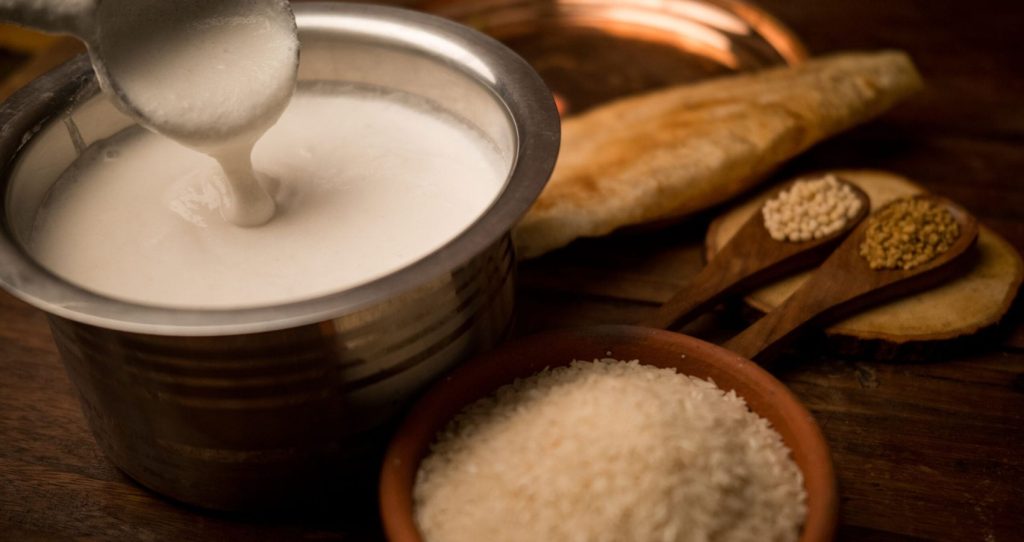Introduction
In South Indian cuisine, a dosa is a thin, Savory crepe cooked from fermented rice and crushed black gram. Dosas are eaten hot, often along with chutney and sambar, a vegetable stew made with lentils. Throughout the world and in South Asia, dosas are a popular food. Dosa is a symbol of South Indian culture and delicious food. It represents heritage, flavour, and the culinary expertise of South Indian cuisine and is more than just a meal because of its adaptability, nutritious content, and ability to unite people. Through this guide, you’ll uncover the secrets behind achieving the ideal batter consistency, harnessing the power of fermentation, and mastering the art of spreading and cooking dosas to golden perfection.
Understanding the Ingredients
Usually, the following ingredients are used to make dosa:
- Rice: Typically, either plain raw rice or parboiled rice are used. Some varieties may use different kinds of rice, such as basmati or sona masuri.
- Whole or split urad dal (black gram lentils) is an essential ingredient. It is soaked with the rice and combined with it to make a batter.
- Fenugreek seeds: Added frequently while soaking urad dal. Fenugreek seeds give a delicate taste to the batter and help with fermentation.
- Salt: A necessary ingredient for improving dosa flavor. In order to balance the flavors, salt is added to the batter.
- Water: Used for soaking the urad dal and rice, as well as for grinding the batter till the right consistency is reached.
These basic ingredients are required to form the dosa batter, which is cooked on a tava or griddle and fermented. To get the right flavor and crispness, you can also cook the dosa on the griddle by adding oil or ghee.
Preparation Beforehand
Soaking
Rice with Urad Dal: First, give each dish a separate wash and rinse. Next, soak them in water for a minimum of 6 to 8 hours or overnight. Fenugreek seeds are soaked with the urad dal in certain recipes as well.
Grinding
Grind Separately: After soaking, take the rice and urad dal out of the water. First, grind the urad dal (and fenugreek seeds, if using) until they are smooth and foamy. Next, separately crush the rice until it has a little grainy texture.
Combine
Combine & Mix: Thoroughly combine the rice batter and ground urad dal. Test out the batter and thoroughly include the salt.
Fermentation
In order to achieve the desired flavor, texture, and digestibility, dosa batter must undergo fermentation.
Detailed fermentation process
After grinding rice and urad dal separately, the batter is mixed thoroughly with salt and water to form a thick but pourable consistency. Transfer the batter to a sizable container big enough to let it expand throughout the fermentation process. Put a towel or a lid on the container. The batter should ferment for 8 to 12 hours, or until it doubles in volume, in a warm, draft-free place. Because it contributes to the texture and flavor of dosas, fermentation is necessary. After the fermentation period, the batter should have increased in volume, become slightly frothy, and developed tiny air bubbles on the surface. It will also emit a slightly sour aroma.
Temperature, consistency of batter and room humidity greatly affect fermentation. To make excellent dosas with the ideal sour flavor and soft texture, you must master the fermentation process in order to achieve the desired taste, texture, and scent in the batter. And also batter consistency, correct preparation of tava with correct temperature and using a non-stick surface and the way of spreading batter and timing and techniques all lead to a perfect tasty dosa.
Storing dosa batter
Dosa batter need to store perfectly to maintain its freshness and quality. Transferring the leftover dosa batter to an airtight container and storing it in refrigerator makes it fresh and usable. Freezing dosa batter isn’t good because it alters the batter’s texture and affects its ability to ferment properly. And the most crucial thing is that hygiene. Maintain cleanliness and hygiene when handling and storing the dosa batter. By following these, you can extend the shelf life of dosa batter and ensure that it remains fresh and suitable for making delicious dosas throughout the week.
Conclusion
Creating dosa batter from scratch is an art that requires precision and patience, but the delightful dosas you’ll savor at the end make every step worthwhile. From washing and soaking the rice and urad dal to the precise grinding process, followed by the patient fermentation period, every step is crucial. More than just a cooking task, making dosa batter at home is an invitation to taste South Indian flavors, a reference to history, and a link to one’s past.
A crispy, golden dosa is the result, which makes the seemingly complicated process worthwhile. Patience, talent, and attention to detail are qualities that the ideal dosa batter possesses. Its texture, flavor, and pungent scent bring back fond memories of family customs. It’s a canvas just ready to be spread out and roasted on a hot pan.
So, as you embark on your dosa-making journey, cherish each step, relish the aroma of fermentation, and savor the joy of serving warm dosas to your loved ones. May the art of dosa batter creation bring you closer to the rich texture of South Indian cuisine and the shared experience of delicious meals made with love and tradition.

